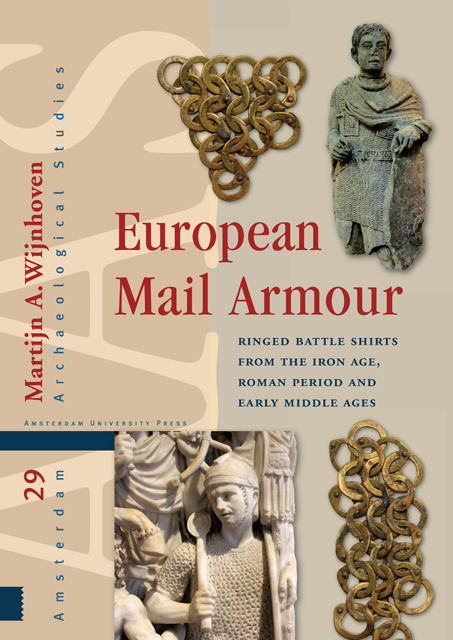Book contents
- Frontmatter
- Contents
- Acknowledgements
- Dedication
- 1 Introduction
- 2 The origins of mail armour
- 3 Distribution and archaeological context
- 4 The iconography of early mail armour
- 5 The naming of mail armour
- 6 Decoration in mail garments
- 7 Padded garments
- 8 The craft of making mail rings
- 9 Weaving patterns
- 10 The construction of mail garments
- 11 Ring characteristics
- 12 Final considerations
- Bibliography
- Database
- Appendix 1 Catalogue of mail armour
- Appendix 2 Catalogue of hybrid armour
- Appendix 3 Catalogue of isolated finds of fasteners and fixtures
- Appendix 4 Finds excluded from the database
11 - Ring characteristics
Published online by Cambridge University Press: 24 November 2022
- Frontmatter
- Contents
- Acknowledgements
- Dedication
- 1 Introduction
- 2 The origins of mail armour
- 3 Distribution and archaeological context
- 4 The iconography of early mail armour
- 5 The naming of mail armour
- 6 Decoration in mail garments
- 7 Padded garments
- 8 The craft of making mail rings
- 9 Weaving patterns
- 10 The construction of mail garments
- 11 Ring characteristics
- 12 Final considerations
- Bibliography
- Database
- Appendix 1 Catalogue of mail armour
- Appendix 2 Catalogue of hybrid armour
- Appendix 3 Catalogue of isolated finds of fasteners and fixtures
- Appendix 4 Finds excluded from the database
Summary
‘In the absence of a known context in which to place seemingly ‘unique’ items like this, there will inevitably be much discussion as to the place and time of their manufacture… and therein lies our problem. It is relatively easy (albeit time-consuming) to record the differences between various disparate examples of mail in collections around the world, but until we can create a reliable database of securely-provenanced and closely dateable mail, anything we may attempt in the way of a dateable mail typology is inevitably likely to be open to argument.’
David Edge
THE RELEVANCE OF THE SEEMINGLY IRRELEVANT
Armour research in Europe grew out of an interest in medieval plate armour. Ever since, studies of this type of armour have mainly been an art historical endeavour through which age and provenance are determined by stylistic comparison. This method works well for objects that are well preserved or relatively intact, but can rarely be applied to archaeological mail armour, which is seldom complete or in a good state. Corroded mail fragments do not lend themselves to stylistic analysis, which is largely why archaeological mail has often been deemed uninformative and thus neglected (see chapter 1.1). Since entire archaeological mail garments are rare, it is more fruitful to shift the analysis to the level of the individual rings to establish age or provenance. Moreover, this approach requires only a few well-preserved rings.
At first glance, the rings in a coat of mail may look the same whatever period or region they originate from. On closer inspection it becomes clear that there are minute, unique differences among them. The main mechanism underlying these differences is the way in which mail makers approached their work. As any craftsperson can attest, there are several ways to make an artefact. The steps in the creation process, the choices made during manufacture, and the tools used to execute them will all affect the final product. The making of an object is not limited to just conscious decision-making and creativity.
- Type
- Chapter
- Information
- European Mail ArmourRinged Battle Shirts from the Iron Age, Roman Period and Early Middle Ages, pp. 259 - 312Publisher: Amsterdam University PressPrint publication year: 2021



